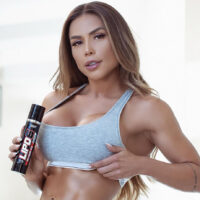So, you’re on track with your exercise and meal plans…
You want to feel good about all of the progression you’ve made but there seems to be one problem hindering your mental capacity to stay the course.
What is it, you ask?
Sugar cravings.
The midnight ‘Oreo devil’ is calling your name every night, double-dog daring you to break your diet.
“Come on, it’s just a couple. It won’t hurt your progress.”
We have all been there.
But here’s the problem – sugar cravings turn into disappointing binge fests. You might feel happy while indulging in your favorite sweets, but this is just temporary and that will quickly fade into a feeling of discouragement and the “why did I just eat all of that?” mentality.
Sugar isn’t just in your favorite childhood snacks or candy. It’s in a lot of your everyday foods, believe it or not.
With sugar being an unsuspecting ingredient in many foods these days, it can be difficult to keep your sugar intake below the recommended amount of 6 teaspoons for women and 9 teaspoons for men, according to the American Heart Association’s information guidelines. [1]
It doesn’t help that sugar has over 50 different names hidden deep in the crevices of unsuspecting ingredient labels. [2]
Going by more popular names such as; honey, caramel, fructose and sucrose among many…
Sugar can successfully pull a massive take-down on your daily limits with its numerous aliases if you aren’t aware of the education behind ingredient labels.
One way to keep your intake down is to suppress your cravings at all costs.
This can become incredibly difficult at certain times with how exposed you are to everyday places including your work, offering candy or sweets during special occasions.
Get your gallon of water at the ready because most health sources suggest quenching your thirst before you dig into all of the sweets.
You may be wondering, “How is drinking water going to help me resist the urge to stuff my face with cake?”.
Well, drinking water and increasing hydration levels is a step to rule out whether you’re just thirsty and not actually hungry.
If you continue to have cravings, consider the following as an alternative to reaching for that bag of candy.
But first, we need to explain the stereotype of sugar and dive a bit deeper into the background before you conquer those dreaded cravings.

Is Sugar Bad for You?
We’re treading murky waters with this specific question.
Sugar is not necessarily bad for you until you overdo it, taking in high amounts with no reasoning other than you like high sugar-based foods.
On the contrary, sugar can actually be used to aid in the benefit for anyone who does a lot of endurance-based training or high-volume workouts to help boost overall energy levels.
Now, this doesn’t mean to go out and pound a baker’s dozen donuts before you go workout.
Adding in more natural sugars you would receive from fresh fruit or vegetables are a nice substitution for energy and glycogen replenishment.
But let’s get into the real reason why too much sugar consumption can be harmful to your body.
Excess sugar intake can lead to many problems but not limited to:
- Obesity and Overweight Problems
- Tooth Decay and Dental Hygiene Issues
- Increased Risk of Diabetes
- Heart Disease and/or Internal Organ Issues
- Gout Related Problems
- Increased Disease Rates
The list continues to go on, but it is important to note that by controlling your sugar intake, you can use sugar to the benefits where necessary.
If you’ve been continuously having issues with sugar intake, try out the following 4 steps to reduce the cravings for sweets and other sugar-based foods alike.
Alternatives to Defeat Sugar Cravings
1. Gum
A stick or two of sugar-free gum will not only provide you with the flavor you are looking for, but it can also satisfy the familiar chewy texture you get with candy.
Additionally, gum’s sticky properties can help you get ‘gunk’ out of your teeth between meals.
Look for gum with Xylitol, as is often recommended by dentists to help prevent tooth decay. [3]
2. Fruit
As stated previously, fresh fruit has naturally occurring sugar properties. If you’re seriously looking to cut-out sugar altogether, be aware that there is a sugar-based profile within fruit and that you may want to seek an additional alternative.
That’s not to say fruit is bad just because it has sugar…
Many fruits contain fiber and essential vitamins, such as; Vitamin C, folate, and potassium which make fruit an important part of a balanced diet. [4]
If you are going to consume sugar, the best bang for your buck is with fruit.
3. Protein
High protein sources such as Greek yogurt and nuts are not only filling, but there are many varieties and flavors to chose from.
Personally, Oikos Triple Zero Greek yogurt is an excellent addition as the nutritional profile fits the everyday diet perfectly with a high protein, low-carb and fat macronutrient profile.
Don’t be scared to get too creative with your yogurt either.
Go ahead, toss some of your favorite berries or fruits into it to match your sweet cravings and dive in.
If you are concerned about fat intake, Greek yogurt comes in low-fat options to provide you with a perfect, nutritionally sound snack.

4. Fresh Air
Sometimes sugar cravings occur when you’re simply bored and looking for a pick-me-up. Take a few minutes away from whatever you’re doing and take a walk around the block or get your heart rate going a bit with some basic exercises.
Getting your mind off of potential physique-destroying foods by taking a walk around the neighborhood or just exercising, in general, will be enough to conquer the cravings.
If you continue to feel strong cravings for sugar after implementing these strategies, assess your sleep and other health factors you may have.
A lack of sleep may leave you seeking that pick-me-up in sugar form when you feel tired throughout the day and become susceptible to make un-healthy choices through the fog of fatigue.
If you have any concerns about your sugar intake, it is always best to speak with your registered physician or doctor to assess any underlying diseases or medical history.
References
2. “Nutrients and Health Benefits.” Choose MyPlate, USDA, 12 June 2015, www.choosemyplate.gov/fruits-nutrients-health.
3. “Sugar 101.” Www.heart.org, American Heart Association, 17 Apr. 2018, www.heart.org/en/healthy-living/healthy-eating/eat-smart/sugar/sugar-101.
4. “Xylitol: Uses, Side Effects, Interactions, Dosage, and Warning.” WebMD, WebMD, www.webmd.com/vitamins/ai/ingredientmono-996/xylitol.








